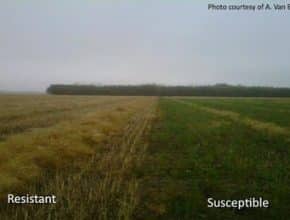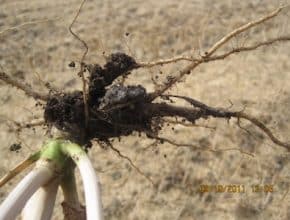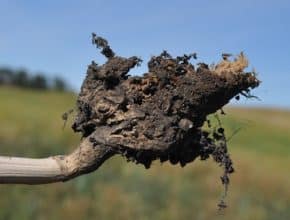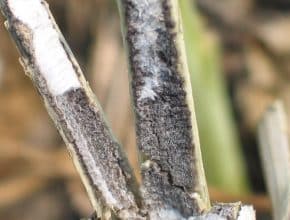Stephen Strelkov with the University of Alberta tested soil samples from 27 fields in Alberta that were seeded to resistant varieties in 2014 and showed more than expected levels of gall formation. Of those 27 fields, 15 have clubroot pathotypes that suggest the clubroot in those fields had overcome the resistance trait…
Clubroot
-
-
A new canola variety was recently registered claiming an "intermediate" reaction to clubroot pathotype 5x, as well as resistance to established clubroot pathotypes 2, 3, 5, 6 and 8. Based on Western Canada Canola/Rapeseed Recommending Committee protocol for clubroot disease resistance, seed that is resistant (R) shows less than 30% infection based on a severity-by-incidence rating, and seed that is…
-
Growing clubroot resistant varieties in areas with low levels of inoculum or areas beside regions known to have clubroot is a good pre-emptive strategy to keep clubroot to a minimum in a particular field. The question for growers in areas with serious blackleg is whether to grow varieties with effective blackleg resistance or grow varieties with clubroot resistance. Current varieties…
-
Discovery of a different clubroot pathotype in central Alberta will change the rotation plans for some growers. No current varieties have resistance to this different pathotype, and varieties with a new effective source of resistance will not be available for at least the next year or two, or maybe longer. Longer rotation is necessary to slow the pathogen shift that…
-
Alberta has started an intense survey to check fields for clubroot pathotype 5x, which is able to overcome all forms of resistance on the market today. The survey will focus on suspicious patches in fields that were grown to an R-rated canola variety. Growers and agronomist who spot suspicious patches in a resistant variety, can contact their County Ag Fieldman…
-
In 2013, an Alberta field was identified where a clubroot resistant variety showed a high incidence of clubroot infection. Subsequent testing by the University of Alberta indicated that all current forms of resistance were not functional on the disease in this soil. This failure of resistance or its breakdown was determined to be due the increasing shift to a previously…
-
Various labs will test soil for clubroot. Those collecting soil samples are advised to park on the road when possible so the vehicle does not pick up infested soil. Follow sanitation procedures if visiting more than one field. This includes using disposal boot covers for each field and cleaning and disinfecting footwear and tools that come in contact with the…
-
While you are out there checking to see if your crop is ready to cut/harvest is a perfect time to also check for disease! Likewise, the representative sampling technique used to accurately determine the stage of the crop is also ideal for disease scouting of your field. Pulling out a few plants and checking for the big three diseases, as…
-
A severe case of clubroot has been found in a canola field in North Dakota, near the Manitoba border. This suggests the disease has been in the area longer than expected. It also confirms expectations that environmental conditions in Manitoba are suitable for clubroot. Close scouting is advised for growers in Manitoba and Eastern Saskatchewan, especially canola fields close to…




